Appreciating Buddhist Art: Part One – Siddhartha Gautama
PRIMITIVE - Friday, May 29, 2015By Misaki Imagawa
Edited by Glen Joffe
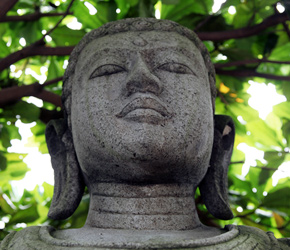 |
|
If you’ve ever taken a trip to Asia and visited Buddhist temples you have surely come across different depictions of Buddha. We may recognize him whether he is standing, sitting or lying down. Sometimes he wears a jeweled crown. At other times, rays of light called a mandorla radiate from behind his head. His eyes may be or open or closed; he may hold objects in his hands; and he may be made from different materials such as copper, iron, gold or jade. He may be painted white, blue, yellow or red; have a normal complement of body parts or multiple heads and arms. He may be tall and thin or short and fat – but wait, let’s stop here. To a casual observer, the many depictions of Buddha can be confusing; and in fact, what looks like Buddha is often not Buddha at all.
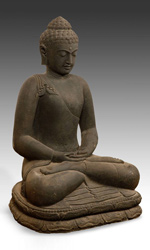 |
|
So who are we talking about when we say Buddha anyway? The historical Buddha was called Siddhartha Gautama and is referred to as Gautama Buddha or the original Buddha. He is also known as Shakyamuni Buddha, Shakya being the name of the royal family he was born into; and ‘muni’ meaning ‘sage’ or ‘the able one’. He lived sometime between the 6th and 4th century BCE in India. Though born a prince, he left behind all his riches and pursued the life of an ascetic. His path later came to be called the middle way, a polite way of describing a lifestyle found somewhere between over indulgence and asceticism. It is said Gautama Buddha meditated on human nature for 49 days under a Bhodi tree until he awoke, having achieved a complete state of enlightenment and liberation from suffering and rebirth.
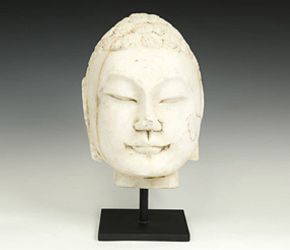 |
|
Many Buddhist artworks depict Gautama Buddha in various stages of his life and teachings. Mudras, or hand and finger postures, offer helpful insights behind the meaning of individual works of art. For example, a statue of Gautama Buddha sitting in meditation with his right fingers pointing down over his knees represents the moment he reached enlightenment. Meanwhile, the left hand can be seen with the palm upright in his lap. This is a mudra called Bhumisparsa, or calling the earth to bear witness. When his hands are raised to his chest with thumbs and index fingers meeting to form a circle, this is the mudra of teaching called Vitarka. It is said that Gautama Buddha took this posture to give his first sermon after reaching enlightenment. Another popular depiction of Buddha shows him lying down on his side. These are often referred to as “reclining Buddhas,” but their formal name is Buddha entering Nirvana. It represents his ascent to heaven and the end to an endless cycle of birth and rebirth.
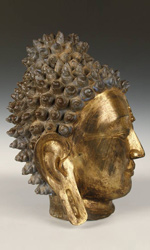 |
|
Looking at Buddha’s face and head can also give an indication of whether you are seeing Gautama Buddha or a different Buddhist figure entirely. The original Buddha’s facial expression is typically serene and his mouth is usually shown smiling slightly. His earlobes are usually shown long where they were once weighed by his heavy jewelry as a prince. Later, the long earlobes became a reflection of his wisdom. Gautama Buddha’s head is almost always covered with many small swirls, which at first glance may look like curly hair. These actually are depicting the 108 Snail Martyrs. As the story goes, the snails came across Buddha meditating under the scorching sun one day and climbed up onto his head to protect him from the heat. They gave their lives for him and to honor their sacrifice, Gautama continued to wear their shells on his head.
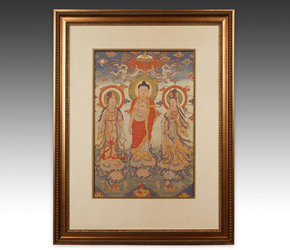 |
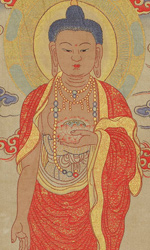 |
||
As Buddhism traveled farther east, each country took its teachings and adapted them to their own traditions and culture. Ultimately, the art of Buddhism and depictions of Buddha began to conform to different regional styles. Consequently, the way Buddha is depicted in Burma is different than Japan, which is different than Nepal, and so on. The art of Buddhism developed from abstract and folk representations of Buddha to extreme life like representations; and as the religion developed and became more expansive, the art began to also depict a growing pantheon of other Buddhist deities. Sometimes, these other deities can be difficult to differentiate from Gautama Buddha.
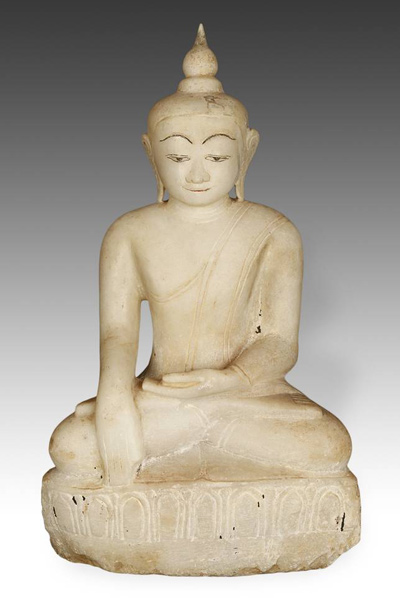 |
|
It is nearly impossible to generalize the subtle and complex styles inherent to countries practicing Buddhism across Asia; however, there are a few identifying characteristics that can be discerned. For example, in Myanmar the Ava Innwa style of Buddha became popular around the 14th to 16th century. This style featured thin, arched eyebrows, half-closed eyes and a prominent pointed knob on the head, called the ushnisha, which is also known as a top knot. In fact, many Southeast Asian depictions of Buddha have a tall and pointed ushnisha. It is symbolic of Buddha’s spiritual power and attainment of enlightenment. In other countries; for example, China and Nepal, the ushnisha is less prominent and rounded. Another variance in style can be seen in the clothing worn by Buddha. For example, in northern countries like Nepal, China, Korea and Japan, Buddha is often depicted wearing long flowing formal robes. In the southern countries of Southeast Asia far less emphasis was placed on the robes. Finally, the Buddhas in most of Asia tend to have fuller, rounder faces compared to the lean and elongated features found throughout Southeast Asia.
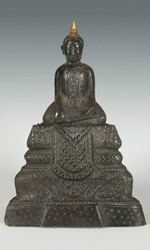 |
|
Although a large part of Buddhist art centers on depictions of Gautama Buddha, there are many other “Buddha-like” portrayals that are easy to confuse. The word “Buddha” means ‘enlightened one’ and although Siddhartha Gautama is considered the supreme and original Buddha, there are other Buddhas – such as the Five Dhyani Buddhas – that are popular in Buddhist artworks. Bodhisattvas, or enlightened ones, are also frequently portrayed in paintings and statues. Perhaps most commonly confused with the historical Buddha is the Laughing Buddha, who originated from folk tales surrounding a Chinese Zen monk. In many ways, Buddhism has evolved alongside pre-existing cultural and religious practices, and nowhere is this more noticeable than in the manifestation of its art.
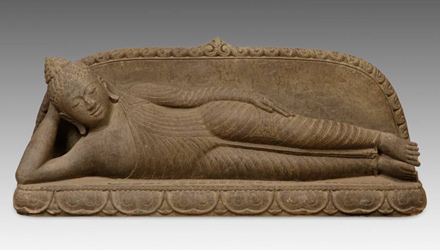 |
Download this Article: Appreciating Buddhist Art Part One.pdf